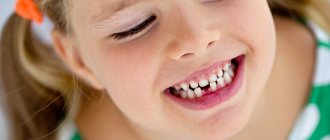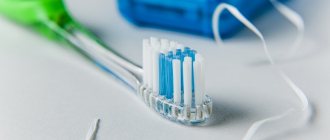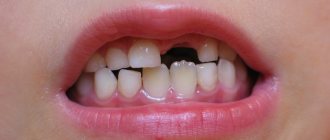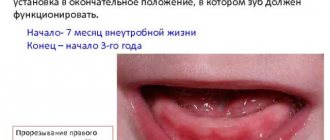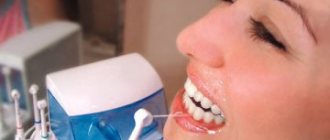Symptoms that indicate that the process has begun:
- Some children experience an increase in temperature (up to 38). In this case, you should not hesitate; it is better to seek advice from your doctor.
- Unpleasant sensations in the gums.
- The space between the teeth increases.
- The roots begin to dissolve (The roots of baby teeth are much shorter than those of permanent teeth. When the process reaches the neck, a tooth change occurs).
- Gums are bleeding.
Everything has its time
One of the most frequently asked questions to our doctors from mothers is: “In what order do teeth begin to fall out?”
It usually starts at the age of 5 years. The very first teeth that undergo this process are the incisors, then the fourth and fifth teeth of the row, then the canines. To make it more clear to you, here is a diagram of the loss and eruption of baby teeth:
Don't worry if your child is over 5 years old and his teeth aren't starting to change. Each child’s body is individual, and much depends on nutrition, dental care, daily routine, and climatic conditions. In girls, the loss of baby teeth begins a little earlier than in boys. If you are still worried, then contact your dentist and conduct an unscheduled examination.
I would also like to note the timing. Complete replacement of milk teeth with molars occurs within 6-7 years. There is no need to specifically tear them out or loosen them. Everything will happen naturally.
The doctor prescribes removal only if the baby tooth has not yet fallen out, but the root tooth is already beginning to grow.
Molars in children
Of course, molars in children deserve a separate discussion. Firstly, because parents often confuse which teeth are milk and which are permanent, and secondly, because their eruption causes extremely unpleasant and even painful sensations and is often accompanied by an increase in temperature.
When do molars grow?
Many parents believe that molars are permanent teeth, that is, those that replace milk teeth. But actually it is not. So what kind of teeth does the child have? In fact, molars are divided into permanent and primary teeth. In this case, the order of eruption of molars in children is as follows. At six months, babies begin to notice their first molars. There are four of them, and they are located on the lower and upper parts of the jaw apparatus. At one and a half years, central molars appear, at two and a half, lateral molars. From 5 to 10 years, baby teeth are replaced by permanent teeth. Until about 25 years of age, the most complex tooth, the “wisdom” tooth, emerges.
What symptoms accompany tooth growth?
Not all parents know how their children’s molars grow, which is why they begin to worry a lot when they notice some unpleasant symptoms. Let's figure out what phenomena accompany tooth growth.
Fever. During the period of teeth growth, children can maintain a temperature of 37–37.5 °C. In some cases it rises to 38 °C. Why is this happening? The fact is that when the gums become swollen, the blood flow increases, and to compensate for the swelling, the body produces biologically active substances, which affects the state of the immune system. As a result, the temperature rises.
General malaise. Very often, when teething, children seem lethargic and tired. This is due to the fact that it is a lot of stress for the body. As a result, the child may have trouble sleeping; babies often become irritable, spit out the pacifier, start sucking their thumbs, and are constantly capricious.
Increased salivation. This is especially observed in young children (aged 5–7 months). At this time, they do not yet independently regulate the amount of saliva in their mouth. A large amount of saliva indicates irritation of the sensitive nerves of the gums, which is completely normal when teeth appear. Over time, with the development of the reflex, the amount of saliva decreases.
Digestive disorder. Teething is often accompanied by vomiting, diarrhea and regurgitation. The reason for this is an increase in the amount of liquid the baby drinks during the day.
How can I help you
In order to speed up the teething process, small children can be given special toys. They are usually made in the form of rings. Instead of these items, you can use a regular crust of bread or peeled fresh carrots. Also during this period, it is recommended that the child be given cool drinks, preferably just water. You can distract babies and older children with the help of games, conversations, and fun music. Do not forget that during this period the child needs double affection and special care from the parents. For severe pain, doctors prescribe age-appropriate analgesics. You can apply a clean, soft cloth soaked in cold water to your gums. This is especially useful before bedtime, as this approach will help relieve pain and allow the child to fall asleep.
Features of baby teeth
Now I will answer another very popular question: “how do baby teeth differ from molars?”
These are the baby's very first teeth. They appear before the age of three, and begin to erupt until there are 20 teeth. See the photo above for the cutting diagram.
They do not have such deep roots as permanent teeth, have a more rounded shape and smaller size, and are white in color, while permanent teeth have a yellowish tint. By location, they are directed vertically, and the radicals are slightly outward.
Wisdom teeth cannot be milk teeth, because they grow into deep roots only by the age of 18-20, and sometimes later.
What does it cost us to build a tooth?
To use stem cells in tissue engineering, the presence of a scaffold and growth factors is required (Fig. 7). An ideal scaffold should support cell attachment, migration, proliferation, and spatial organization.
Figure 7. What does it cost us to build a tooth?
website dentistry.tamhsc.edu
Basically, a scaffold as a suitable matrix for tissue reconstruction should meet the following requirements [21]:
- Ease of use.
- The presence of pores of a certain shape and size for the diffusion of cells, growth factors, nutrients and removal of waste products.
- The ability to biodegrade, which occurs at a certain time without releasing toxins.
- Biocompatibility with body tissues.
- Low immunogenicity.
- Ability to be replaced by regenerating tissue and vascularization.
- Good physical and mechanical properties.
The materials used to form scaffolds are divided into natural and synthetic (Fig. [22]. Bioactive glass, polylactic acid, various composites (multicomponent materials based on a matrix based on metal, polymer or ceramic) - all these are synthetic materials. Despite the fact that these materials make it possible to produce scaffolds of the required shape, their use is very limited due to unsatisfactory biocompatibility and toxicity. Among the biomaterials (natural materials) used to create scaffolds, collagen, chitosan, and hyaluronic acid can be distinguished. They consist of macromolecules that They are also part of the extracellular matrix, therefore they are biocompatible and highly biodegradable, but they are less durable and can cause rejection reactions [21].
[22]. Bioactive glass, polylactic acid, various composites (multicomponent materials based on a matrix based on metal, polymer or ceramic) - all these are synthetic materials. Despite the fact that these materials make it possible to produce scaffolds of the required shape, their use is very limited due to unsatisfactory biocompatibility and toxicity. Among the biomaterials (natural materials) used to create scaffolds, collagen, chitosan, and hyaluronic acid can be distinguished. They consist of macromolecules that They are also part of the extracellular matrix, therefore they are biocompatible and highly biodegradable, but they are less durable and can cause rejection reactions [21].
Figure 8. 3D scaffold of mouse and human teeth. a — Lower central incisor of a mouse. b — Human lower first molar. 3D reconstruction and bioprinting were used. Material: hydroxyapatite and polycaprolactone. Microchannels (d = 200 nm) into which MSCs and growth factors are introduced ( c and d ) are visualized.
[22]
The most suitable scaffold that meets most requirements is either a scaffold derived from extracellular matrix ( ECM scaffold ) or its analogue. Due to their identity with the extracellular matrix, such scaffolds are able to provide the best interaction with cells and growth factors. Dental MSCs, such as pulp and periodontal stem cells, when cultivated in ECM scaffolds, underwent differentiation in the odontogenic direction. After implantation of this scaffold, the pulp was formed [10], [23].
In addition to the scaffold and stem cells, a link is needed that connects them, which would regulate tissue growth. These can be growth factors, certain genes, and interfering RNAs [7].
Growth factors are peptide molecules that transmit signals to control cellular behavior and interact with specific receptors on the surface of cells [24]. They provide interconnection and interaction between cells and the extracellular matrix. Following cell damage, the secretion of growth factors begins, which subsequently trigger the processes of regeneration and angiogenesis. An example of the “work” of growth factors in a tooth is the formation of secondary and tertiary dentin, which occurs when the carious cavity is close to the dental pulp or when teeth are subject to increased abrasion. Key growth factors during tooth development include bone morphogenetic protein (BMP), platelet-derived growth factor (PDGF), and fibroblast growth factor (FGF). They are primarily used in dental tissue engineering [25–27]. Both cells and nanoparticles, as well as the scaffold itself, can be used to deliver growth factors.
Daily doctor's advice on caring for baby teeth:
- Start brushing your baby's teeth only after they have erupted; use a special brush for babies.
- When your child turns one year old, buy a brush with soft bristles and toothpaste without fluoride; it will not harm the child if he swallows it.
- Brush your baby's teeth 2 times a day (morning and evening)
- Don't put off going to the dentist. They should be regular, even if there are no signs of concern.
- Include more fresh greens, fruits and vegetables in your diet.
Vitamins for teeth and gums
The baby should take vitamins to strengthen teeth and gums regularly, without missing a single day. This is the only way the child will receive a sufficient amount of nutrients. The daily complex must include:
- Retinol (vitamin A). An element necessary for bone growth. It is vitamin A that promotes protein synthesis in cartilage and bones, and also increases the cartilage layer in the growth zone. If a child's body does not have enough retinol, the process of bone tissue growth slows down, and new teeth may grow crooked. In addition, with vitamin A deficiency, the development of stomatitis and gum inflammation is often observed. In advanced cases, teeth may begin to fall out.
- Calciferol (vitamin D) is one of the key components of bone development. It is thanks to this vitamin that a child’s bones develop normally and mineral metabolism is regulated. Calciferol, as the name implies, helps absorb calcium and strengthens bone tissue. In summer and spring, a child can get vitamin D from sunlight by simply walking outside often. But in winter and autumn it is important to give children vitamin complexes with calciferol. With a deficiency of this element, mineral metabolism can be disrupted, bone tissue softens, rickets appears, and, of course, tooth enamel becomes thinner.
- Vitamin C is essential for strengthening gums. If there is a lack of ascorbic acid, the child may experience tissue bleeding, in advanced cases, ulcers appear in the mouth, an unpleasant odor disturbs, and teeth begin to loosen and fall out.
- Vitamins B6 (pyridoxine) and B12 (cyanocobalamin) are also needed to strengthen gums. It is B12 that provides tissue strength and prevents various inflammations, and the lack of cyanocobalamin makes the gums very sensitive.
- Vitamin E is involved in wound healing and helps fight pustules that so often appear on the gums of babies.
- Vitamin K (phylloquinone) strengthens connective tissue and protects gums from bleeding.
- Vitamin PP (nicotinic acid) is an important protector of gums from gingivitis, stomatitis and other inflammations.
Doctor's advice when the process of changing teeth begins:
- After tooth loss, let your baby not eat for 3 hours, and you should also not drink very cold or hot drinks.
- Protect your child from sour, spicy and very sweet, astringent foods. All this has a negative impact on teeth.
- If your baby is bothered by discomfort or pain after a baby tooth falls out, then buy a special gel, but it is better to choose it on the recommendation of a dentist.
- Do not let your child touch the hole where a tooth has fallen out, as it may become infected.
- To soothe your mouth, make a decoction of chamomile.
Forward to the future!
Of course, there is no doubt that dental bioengineering will soon become an integral part of standard protocols for the treatment of dental lesions. It is possible that regenerative dentistry techniques will allow us to create a complete dentogingival complex. It is important to remember that methods developed in accordance with the requirements and objectives of dental bioengineering will be able to spur the development of new approaches to the regeneration of other tissues and organs and thus contribute to progress not only in dentistry, but also in the field of regenerative medicine in general. Well, forward to the future!
